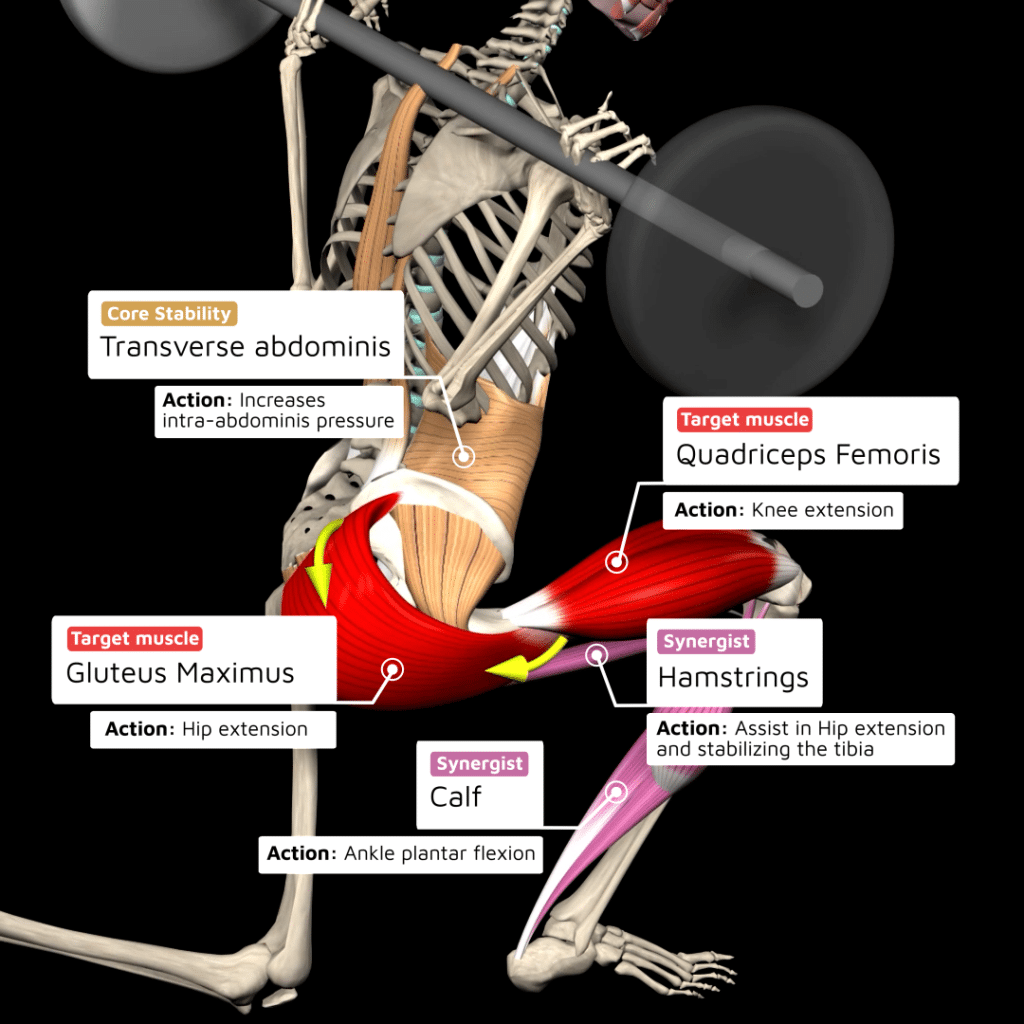The Lunge exercise is a fundamental lower-body movement that targets various muscle groups and is a valuable addition to any workout routine. Lunges engage not only the quadriceps but also the glutes, hamstrings, and more. Discover the proper technique for performing Lunges and achieving stronger legs with this detailed Muscle and Motion guide.
Which Muscles Work During Lunges?
Lunges are a versatile and effective exercise that engages multiple muscle groups in the lower body. By incorporating lunges into your workout routine, you can target and strengthen key muscles such as the quadriceps, glutes, hamstrings, calves, and core.
This comprehensive exercise not only improves strength and stability but also helps enhance your balance.
Lunges primarily target the following muscles:
- Quadriceps: The quadriceps, located at the front of the thigh, is the primary muscle engaged during lunges, and it is in charge of extending the knee.
- Glutes: The gluteal muscles, particularly the gluteus maximus, are engaged during lunges and are in charge of extending the hips and stabilizing the pelvis.
- Hamstrings: The hamstrings, located at the back of the thigh, act as synergists during the lunge and help to control the descent and assist in knee flexion.
- Calves: The calf muscles, including the gastrocnemius and soleus, assist ankle plantar flexion in the front leg.
- Core muscles: Lunges require core stability and engagement to maintain hip and pelvic stability and balance throughout the exercise.
Additionally, lunges also involve secondary muscles such as the hip adductors, hip abductors, and spinal erectors to provide stability and support during the movement. By targeting these muscles, lunges offer a comprehensive lower-body exercise that can help improve strength and stability.

How to Lunge Properly: Step-by-Step
- Start by standing tall with your feet hip-width apart and your hands either on your hips or relaxed by your sides.
- Take a step forward with your foot, ensuring your knee is above your ankle.
- Lower your body by bending both knees until your thigh is parallel to the floor. Keep your knee hovering just above the ground.
- Keep your upper body upright, with your chest lifted and your core engaged.
- Push through your heel and drive your body back up to the starting position.
- Alternate between your legs, switching sides with each repetition for the desired number of sets or repetitions.
Additional Tips for Proper Lunges:
- Maintain proper form throughout the exercise, keeping your knees in line with your toes and avoiding any inward collapsing or twisting.
- When transitioning back to the starting position from a lunge, exert maximum force through your front leg by pushing off with it, instead of relying primarily on your rear leg.
- If you have issues keeping your balance, you can perform lunges near a wall or hold onto a stable surface for support.
- Gradually increase the difficulty of your lunges by incorporating dumbbells or kettlebells for added resistance.
The Difference Between Lunges and Split Squats:
When it comes to lower body exercises, lunges, and split squats are often mentioned. Not only do these exercises seem nearly the same, they also do strengthen the same muscles, but each in a slightly different way.
To understand their unique characteristics and benefits, let’s explore the difference between these two exercises:
-
Lunges:
Lunges are dynamic exercise that involves stepping forward, backward, or laterally. They offer versatility in movement directions and target the lower body muscles. Lunges improve reactive strength and dynamic balance. They can be used for various goals and enhance overall lower body strength.
-
Split Squats:
Split Squats, on the other hand, are a stationary exercise where the legs remain fixed on the ground. The movement originates from the hip and knee joints. Split squats also target the lower body muscles and contribute to improving static balance.
Both exercises are excellent and can be incorporated into your routine based on your goals. Ideally, including lunges and split squats in your workout routine is beneficial to enjoy their combined advantages.
Here’s a helpful tip to assist you in choosing the exercise that suits you best:
- If you intend to work with heavy weights, the split squat is ideal due to its added stability during the movement.
- However, lunges are a great choice if your goal is to improve dynamic balance.
In summary, lunges are a versatile lower-body exercise that targets multiple muscles and improves balance and stability. Incorporating lunges into your workout routine with proper form and technique can strengthen your quadriceps, glutes, hamstrings, calves, and core, leading to stronger legs and enhanced overall lower body function.
Want to learn more about different lunge variations? Check out our article Effective Lunge Variations for a Challenging Workout for further insights.
At Muscle and Motion, we believe that knowledge is power, and understanding the ‘why’ behind any exercise is absolutely essential for your long-term success.
Let the Strength Training App help you achieve your goals! Sign up for free.


